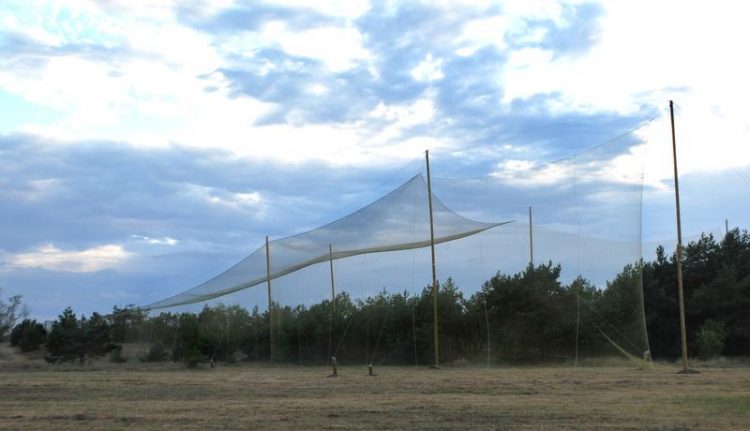The world’s first bat net for migrating bats is launched in Latvia

Catching device for bats. Photo: IZW/Oliver Lindecke
The trap was built by Latvian and German biologists and designed to capture bats en route when migrating along the shore of the Baltic sea to central and southwestern Europe. The research project is part of a collaboration between the German Leibniz Institute for Zoo and Wildlife Research (IZW) and the Institute of Biology of the Latvian University of Agriculture.
“Owing to decades of bird banding, ornithologists already know much about the migration of birds. However, the study of bat migration is still in its infancy. This is due to the fact that there are very few places worldwide where it is possible to observe and catch migrating bats in sufficient numbers.
The conservation area in Pape is unique in this regard, as bats concentrate in this area because of a so-called ‘bottleneck effect’. In Pape, the migration path towards the south is narrowed in a natural way by the shoreline of the Baltic Sea and Lake Pape. Therefore, migrating bats have to pass this narrow stretch of land. There is no other place in Europe to observe so many migrating bats at the same time”, states bat scientist Gunārs Pētersons, associate professor at the Latvian University for Agriculture.
Biologists estimate that with the help of the new 15 meter high funnel trap it will be possible to catch up to 1,000 bats per night. The researchers will ring as many animals as possible in order to figure out which migratory corridor they use.
All animals will be released immediately after they were banded. Previous efforts in banding bats at Pape in the 1980s and 1990s revealed that bats may travel distances of more than 1,900 km between their summer and hibernation areas. For example, some Nathusius pipistrelles, which had been ringed in Pape, were observed in southern France or Benelux countries.
The trap will help scientists to answer further questions about the life of migrating bats. It is for example unknown whether migrating bats use special migration corridors, or which summer and hibernation areas are linked. This infomation could contribute to the improved conservation of migrating bats.
Migrating bats face many conservation challenges, including the negotiation of the many new wind farms set up in Germany and many other European countries. Wind turbines are deadly traps for many wildlife speices, especially migrating bats.
Approximatly 300,000 bats are currently estimated to die per year at German wind turbines alone. Mitigation measures that balance the interests of renewable energy generation with protecting migrating bats are possible in principle and revolve around the adjustment of operational procedures in relation to the timing of main bat activity on a daily and seasonal level.
The new funnel trap in Pape will be officially inaugurated by the director of the Institute for Biology of the Latvian University of Agriculture, Prof Dr Viesturs Melecis and the director of the Leibniz Institute for Zoo and Wildlife Research (IZW), Prof Dr Heribert Hofer DPhil, as well as the leading Latvian and German scientists Prof Dr Gunārs Pētersons and PD Dr Christian Voigt. The opening event will take place on August 19, 2014 at the ornithological field station in Pape (region Rucava, Latvia).
Contact
University of Lattvia
Associated Prof Dr biol Gunārs Pētersons
Tel.:+371 29439097
gunars.petersons@llu.lv
Dr biol Oskars Keišs
Tel.: +371 29236300
oskars.keiss@lu.lv
Leibniz Institute for Zoo and Wildlife Research (IZW)
Alfred-Kowalke-Str. 17
10315 Berlin
PD Dr Christian C Voigt
Tel.: +49 30 5168-517
voigt@izw-berlin.de
Steven Seet
(Public Relations)
Tel.: +49 30 5168-125
seet@izw-berlin.de
The Leibniz Institute for Zoo and Wildlife Research (IZW) investigates the vitality and adaptability of wildlife populations in mammalian and avian species of outstanding ecological interest that face anthropogenic challenges. It studies the adaptive value of traits in the life cycle of wildlife, wildlife diseases and clarifies the biological basis and development of methods for the protection of threatened species. Such knowledge is a precondition for a scientifically based approach to conservation and for the development of concepts for the ecologically sustainable use of natural resources.
Media Contact
All latest news from the category: Life Sciences and Chemistry
Articles and reports from the Life Sciences and chemistry area deal with applied and basic research into modern biology, chemistry and human medicine.
Valuable information can be found on a range of life sciences fields including bacteriology, biochemistry, bionics, bioinformatics, biophysics, biotechnology, genetics, geobotany, human biology, marine biology, microbiology, molecular biology, cellular biology, zoology, bioinorganic chemistry, microchemistry and environmental chemistry.
Newest articles

High-energy-density aqueous battery based on halogen multi-electron transfer
Traditional non-aqueous lithium-ion batteries have a high energy density, but their safety is compromised due to the flammable organic electrolytes they utilize. Aqueous batteries use water as the solvent for…

First-ever combined heart pump and pig kidney transplant
…gives new hope to patient with terminal illness. Surgeons at NYU Langone Health performed the first-ever combined mechanical heart pump and gene-edited pig kidney transplant surgery in a 54-year-old woman…

Biophysics: Testing how well biomarkers work
LMU researchers have developed a method to determine how reliably target proteins can be labeled using super-resolution fluorescence microscopy. Modern microscopy techniques make it possible to examine the inner workings…





















